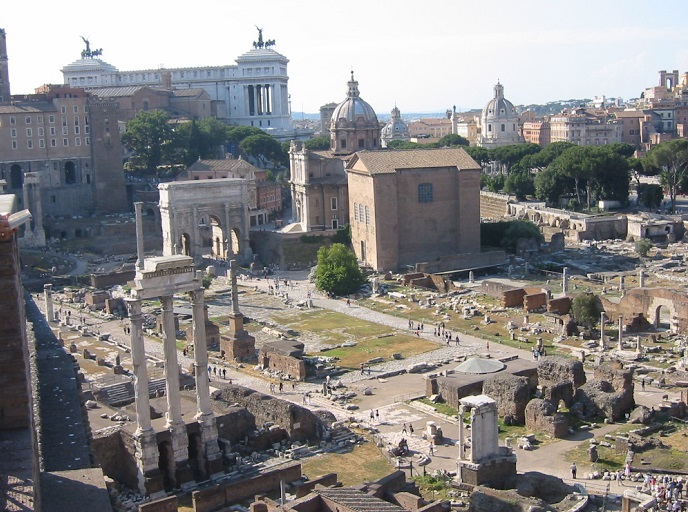
Your virtual vacation to Italy continues as Thor and I explore the ancient Roman Forum, center of political, religious, and commercial life.
NOTE: Since travel is still on hold with the pandemic continuing, I’ve started a new blog series offering a virtual vacation and time-travel to my first big trip with Thor in 2008. Italy! Starting with highlight photos posted here on Saturday, Jan. 30, I’ll continue every week. Join us in Rome, Florence, Cinque Terre, Venice, and Milan. Buon viaggio!
After last week’s visit to the Colosseum, Thor and I crossed the street to the sprawling complex of ruins of the Forum, once the heart of ancient Rome. The Roman entity, from settlement to republic to empire to decline and defeat, lasted a thousand years, from roughly 500 B.C. to 500 A.D. Julius Caesar was the first to be declared emperor and later deified. His adopted son and successor, Augustus Caesar, initiated the “Pax Romana” Roman Peace that lasted from 1 to 200 A.D., the empire stretching from England to Egypt, Turkey to Morocco.
The Forum was originally a marshy valley. When the Romans moved into the area and organized, they built a meeting place here in the 6th century B.C., as well as the first temples, to Saturn, Vulcan, Mars, and Vesta. (As mentioned last week, the Romans coopted much of Greek culture and religion, renaming most of their deities.) The first Forum buildings were burned by invaders; building began again in the 3rd century B.C. Around 50 B.C., Julius Caesar rebuilt much of it on grand scale. It functioned as the city’s political, religious, and commercial center – and as its symbolic center for hundreds of years.
Seen from surrounding hills or in a ramble through it, the Forum looks like mostly rubble, and certainly can’t compare for impressive beauty with the Athens Acropolis and its marble temples, but there’s a lot of important history packed into this space.
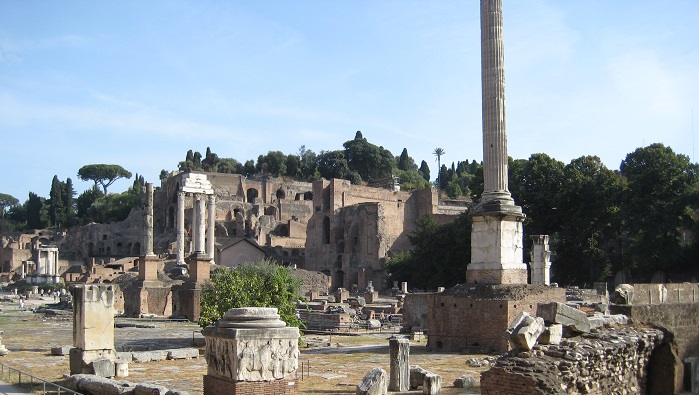
From Rick Steves Rome 2017 : “Picture being here when a conquering general returned to Rome with crates of booty. The valley was full of gleaming white buildings topped with bronze roofs. The Via Sacra—the Forum’s Main Street—would be lined with citizens waving branches and carrying torches. The trumpets would sound as the parade began. First came porters, carrying chests full of gold and jewels. Then a parade of exotic animals from the conquered lands—elephants, giraffes, hippopotamuses—for the crowd to ‘ooh’ and ‘ahh’ at. Next came the prisoners in chains, with the captive king on a wheeled platform so the people could jeer and spit at him. Finally, the conquering hero himself would drive down in his four-horse chariot, with rose petals strewn in his path.”
It’s a confusing place, so we’ll start with the main features as we left the Colosseum and ghosts of gladiators. Unfortunately, Roman history features more bloodshed in the form of aggressive wars for power and territory.
Arch of Constantine:
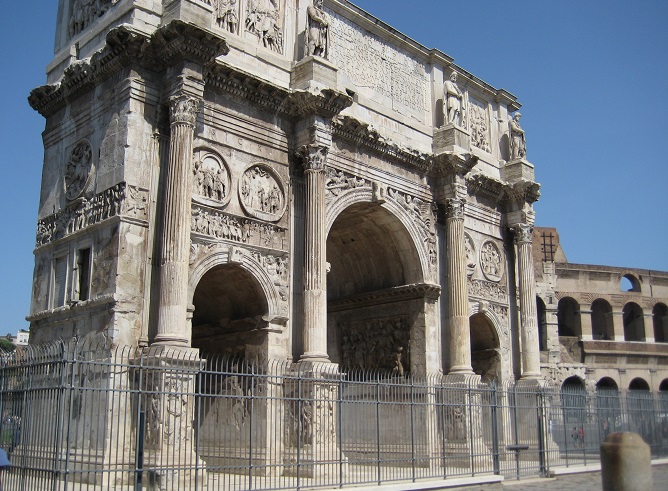
Before entering the Forum enclosure, Thor and I admired the Arch of Constantine, the largest known triumphal arch. It commemorates his battle victory over his rival, Emperor Maxentius, in 312 A.D. Apparently Constantine wanted to legitimize his new rule by incorporating a sort of museum of elements repurposed from various older buildings: four Corinthian columns from around 150 A.D. and relief carvings from previous emperors’ rules, thus connecting him with their august lineage.
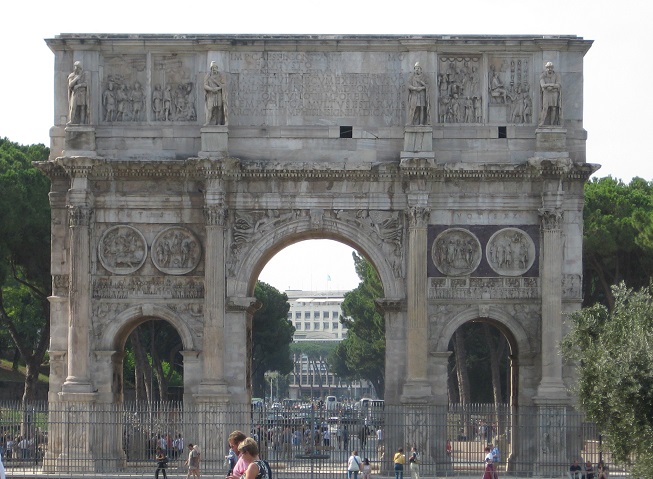
The construction of the arch marked a huge turning point in history, as Constantine declared Christianity the official religion of the Roman Empire. Again from Rick Steves: “With this one battle, a once-obscure Jewish sect with a handful of followers became the state religion of the entire Western world. In A.D. 300, you could be killed for being a Christian; a century later, you could be killed for not being one. Church enrollment boomed.”
Past the arch, the Via Sacra (Sacred Way) leads into the Forum, and:
Temple of Venus and Roma (Roma Amor):
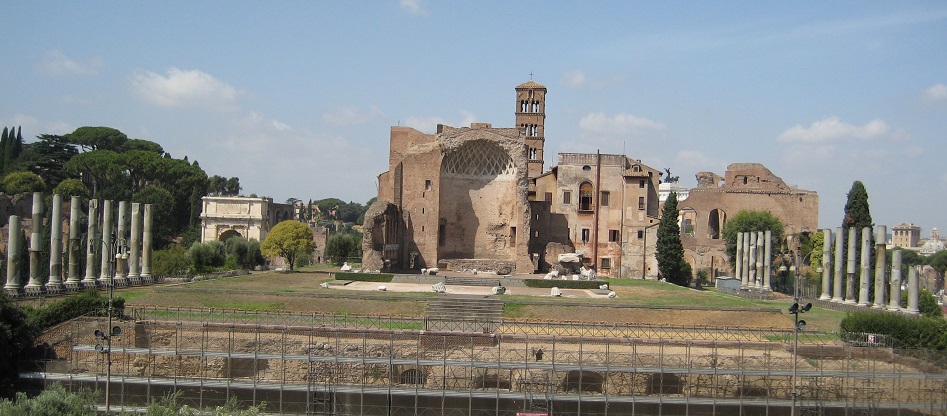
This temple was the largest in the Forum, the size of a football field, and at 100 feet tall, one of highest. Built in the Greek style, it was surrounded by white columns 6 feet thick and topped with a triangular pediment above the entrance. The remaining arched brick with the cross-hatched ceiling was the cella or sacred chamber. It sheltered two huge statues standing back to back. Venus (Amor), the goddess of love renamed from the Greek Aphrodite, faced the Colosseum. Talk about irony: “Love” facing that bloody edifice! The goddess Roma Aeterna faced the Forum. Together, they created a palindrome to link Roma and Amor. Newlyweds asked for blessings here, and the (newer) church tower behind it remains a popular place for weddings.
Arch of Titus:
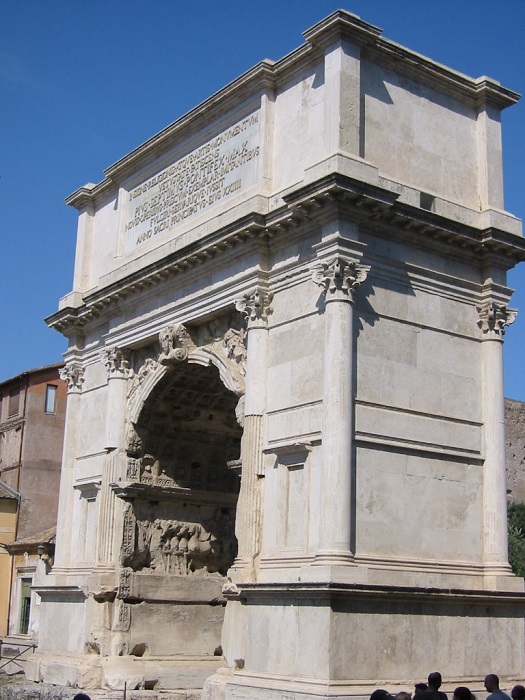
This arch commemorates Roman victory over Judaea (Israel) in 70 A.D. Romans were generally lenient in regard to conquered religions, if the new territory adopted Roman gods along with its own. The Jews would not accept that, and rebelled against Roman tyranny. After a short, bitter war, the Romans won Jerusalem and tore down the Temple, leaving only the “Wailing Wall” behind. They brought home 50,000 slaves, who were forced to build this arch and the Colosseum. The defeat led to the Jewish Diaspora.
Inside the arch are several carvings, including this one showing the Temple treasures being brought to Rome, including a menorah and altar.
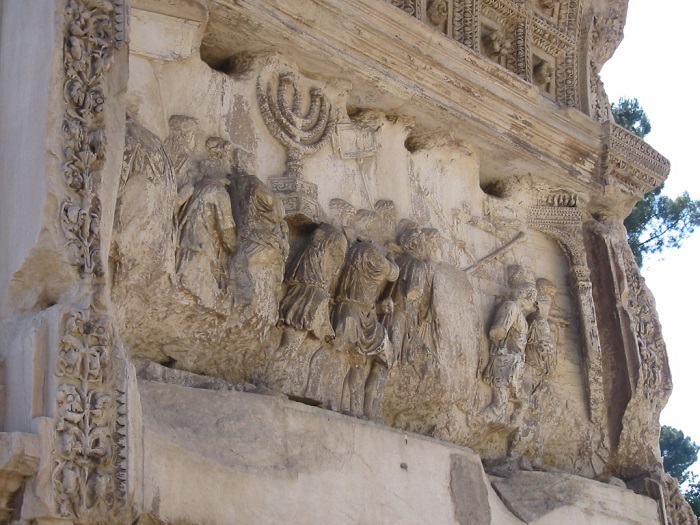
On the curved ceiling, Emperor Titus rides to heaven on an eagle, to become a god.
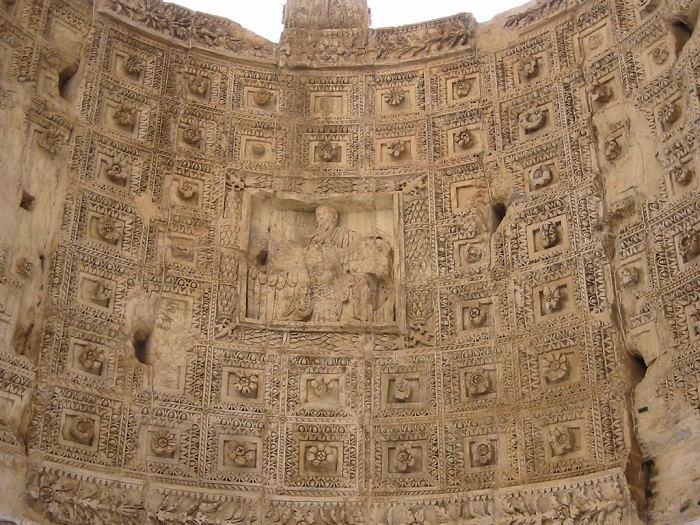
Basilica of Constantine (Basilica Maxentius):
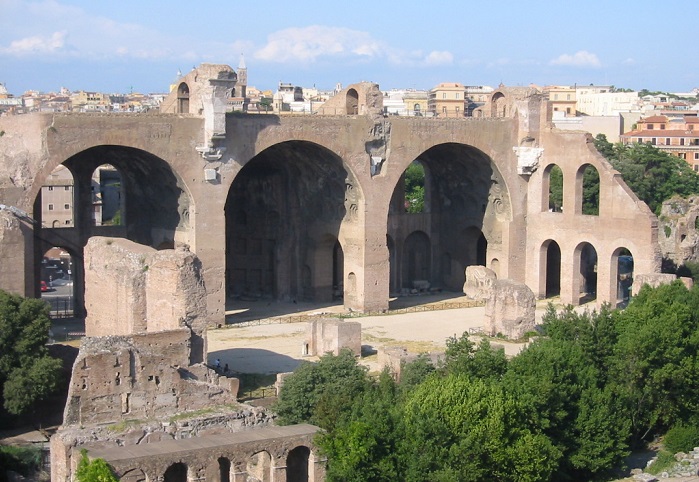
In Rome, a basilica was a covered public forum, often a hall of justice like this one. These big arches represent only a third of the original huge hall, as long as a football field. (You might be able to spot two relatively tiny people in the shade at middle left in photo.) It was begun by Emperor Maxentius, then finished by his vanquisher Constantine. It must have been a real showplace inside, with colorful inlaid marble, a gilded bronze ceiling, and many statutes where citizens could wander through.
Medieval Christians used the Roman basilicas as a model for their large churches, and all cathedrals still have same basic floor plan: a long, rectangular building with columns along a central hall flanked by two side aisles.
This project of emperors Maxentius and Constantine was the last of the major buildings erected in the Forum, in the early 4th century A.D. Not long after, Rome fell into its decline.
Temple of Vesta:
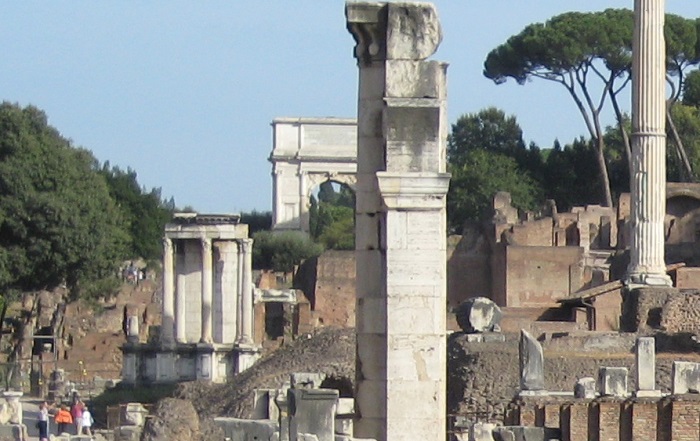
This lovely small temple was circular in design, originally surrounded by twenty fluted columns, built in the 4th century A.D., over the site of much earlier temples. (Above, small temple on left, with Arch of Titus in the background.)
The Romans had a lot of deities, major and minor, including those coopted from the Greeks and many more from other conquered lands. They had gods and goddesses for everything, from Statulinus to help children stand up to Sterculinus the manure god to Venus Cloacina the sewer goddess. But Vesta was one of the most important, renamed from Greek Hestia, goddess of the Hearth, and heart of all things domestic. Her cult was one of the oldest in Rome.
Sixteen Vestal Virgins, recruited from aristocratic families at the age of between six and ten, kept vigil to make sure the sacred flame in the temple never went out. The security and prosperity of Rome was considered tied to the eternal flame and to the purity of the Virgins. If the wind blew out the flame, those guarding it were flogged. During her thirty-year period of service, if a Vestal Virgin strayed from duty so far as to lose her virginity, she would be given a loaf of bread and a lantern, then buried alive in a crypt.
Next to the temple was the House of the Vestal Virgins, where they lived in honored comfort, as long as they kept to their vows. They could enjoy a central garden with fountains and statues that honored famous Virgins of the cult. Today only footings of the house remain. An image of Vesta, or perhaps one of her Virgins (from Wikipedia):
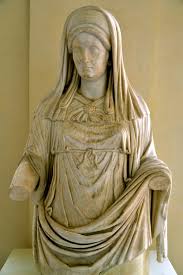
Next week we’ll continue our exploration of the rest of the Forum, then we’ll move forward in history in following weeks.
*****
You will find The Rambling Writer’s blog posts here every Saturday. Sara’s latest novel from Book View Cafe is available in print and ebook: The Ariadne Connection. It’s a near-future thriller set in the Greek islands. “Technology triggers a deadly new plague. Can a healer find the cure?” The novel has received the Chanticleer Global Thriller Grand Prize and the Cygnus Award for Speculative Fiction. Sara has recently returned from another research trip in Greece and is back at work on the sequel, The Ariadne Disconnect. Sign up for her quarterly email newsletter at www.sarastamey.com

1 thought on “The Rambling Writer’s Italy, part 3: The Roman Forum”